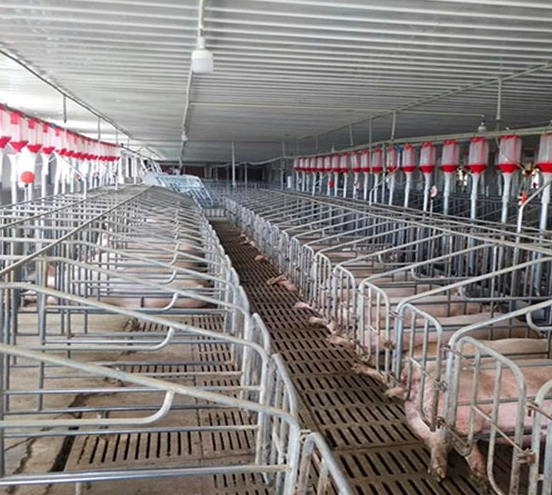
Optimizing Livestock Housing: Steel Cow Barns and Pig Sheds for Efficiency and Animal Welfare
Modern livestock farming demands more than just shelter—it requires durable, efficient, and welfare-oriented housing for animals. For B2B buyers and international farm developers, investing in steel cow barns and pig sheds ensures long-term efficiency, better animal health, and high operational returns.
Steel structures are increasingly preferred over traditional wood or concrete barns because they offer strength, hygiene, flexibility, and ease of maintenance. This article explores best practices for designing, installing, and maintaining steel livestock housing to maximize both animal welfare and business efficiency.
1. Why Steel Structures Are Ideal for Livestock Housing
Steel barns and sheds offer numerous advantages compared to traditional materials:
- Durability and Strength: Resistant to rot, termites, and extreme weather, ensuring a lifespan of 20–30 years or more.
- Hygiene and Cleanability: Smooth steel surfaces prevent bacterial buildup and are easy to clean, reducing disease risk.
- Design Flexibility: Steel frames allow large, open interiors, adjustable stalls, and future expansions.
- Fast Construction: Prefabricated steel components enable rapid on-site assembly.
- Sustainability: Recyclable steel contributes to eco-friendly farming practices.
These features make steel livestock buildings highly attractive for export projects and large-scale farm operations.
2. Key Design Considerations for Cow Barns and Pig Sheds
Proper design is critical to ensure animal comfort, productivity, and operational efficiency.
A. Space Allocation
- Cows: Stalls should be 3.6–4m² per animal for dairy breeds, with sufficient feeding and resting areas.
- Pigs: Pens should provide at least 0.6–1m² per pig, depending on size and age.
- Proper spacing prevents stress, disease, and injuries.
B. Ventilation and Airflow
- Well-ventilated barns reduce heat stress and ammonia buildup.
- Steel structures can incorporate ridge vents, louvers, and mechanical fans for optimal airflow.
- Good ventilation improves air quality, animal health, and productivity.
C. Natural Lighting
- Skylights and translucent panels provide daylight, reducing energy costs and supporting natural behaviors.
- Proper lighting enhances feed intake, milk production, and animal welfare.
D. Flooring and Drainage
- Non-slip, easy-to-clean flooring is essential. Options include concrete with rubber mats or slatted floors for manure management.
- Sloped floors and efficient drainage prevent water accumulation and improve hygiene.
E. Structural Safety
- Steel frames should be coated or galvanized to prevent rust.
- Rounded edges, secure fastenings, and proper bracing minimize injury risks for animals and staff.
3. Maintenance and Operational Efficiency
Even durable steel barns require routine care to maintain long-term performance and hygiene:
- Inspect Coatings and Frames: Check for corrosion or peeling paint; reapply anti-rust coatings as needed.
- Clean and Sanitize Regularly: Pressure wash floors, walls, and feeding areas to reduce pathogens.
- Check Ventilation Systems: Ensure fans and vents are functioning properly for consistent airflow.
- Monitor Structural Integrity: Inspect roof panels, bolts, and bracing to prevent damage during storms or heavy snow.
- Floor and Pen Maintenance: Repair cracks or worn-out mats promptly to prevent injuries.
Efficient maintenance increases animal productivity and reduces long-term repair costs.
4. Enhancing Animal Welfare
Animal welfare is critical for both ethical reasons and productivity:
- Comfortable Resting Areas: Soft bedding and well-sized stalls reduce stress and increase milk production in cows.
- Temperature Control: Ventilation and insulation maintain optimal temperatures in extreme climates.
- Access to Feed and Water: Automated or well-planned feeding systems improve efficiency and animal health.
- Behavioral Enrichment: Space for movement and social interaction promotes natural behavior.
Steel structures allow easy integration of these welfare features, supporting higher output and better-quality livestock.
5. Export and Installation Considerations for B2B Buyers
Steel livestock buildings are highly suitable for export because of modular design and ease of assembly:
- Prefabricated Kits: Components arrive ready for assembly, reducing labor requirements and construction time.
- Flat-Pack Shipping: Efficient packaging lowers freight costs for overseas projects.
- Compliance with International Standards: Designs can meet ISO, CE, or local agricultural regulations.
- Customizable Layouts: Barns and sheds can be adapted for farm size, local climate, and animal type.
- Installation Support: Many suppliers provide detailed manuals or on-site guidance to ensure proper assembly.
These advantages make steel barns and pig sheds a reliable choice for international farm developers and B2B buyers.
6. Sustainability and Long-Term Investment
Investing in steel livestock housing is not only practical but also environmentally responsible:
- Recyclable Steel Frames: Reduce environmental impact and support circular construction.
- Energy Efficiency: Insulated panels lower heating/cooling costs and maintain comfortable temperatures.
- Durable Materials: Reduced need for frequent replacement lowers material consumption and operational costs.
- Optimized Waste Management: Properly designed barns improve manure handling, reducing environmental pollution.
For B2B buyers, this translates into lower lifetime costs, high ROI, and sustainable farming practices.
7. Practical Applications Across Livestock Farms
Steel barns and sheds are versatile, suitable for various livestock operations:
- Dairy Farms: High-capacity cow barns with automated feeding and milking zones.
- Pig Farms: Segmented sheds for sows, piglets, and finishing pigs.
- Beef Cattle Farms: Open-layout barns for grazing cattle or feedlots.
- Mixed Livestock Farms: Modular layouts to accommodate cows, pigs, and poultry under one management system.
The modular design allows farms to scale operations quickly or relocate structures if needed.
Conclusion
Steel cow barns and pig sheds provide a durable, efficient, and welfare-friendly solution for modern livestock farming. By implementing best practices in design, installation, and maintenance, farm developers and B2B buyers can ensure healthy animals, reduced operational costs, and long-term ROI.
For export clients, prefabricated steel livestock housing offers speed, reliability, and global adaptability, making it an ideal investment for sustainable and profitable farming operations.
